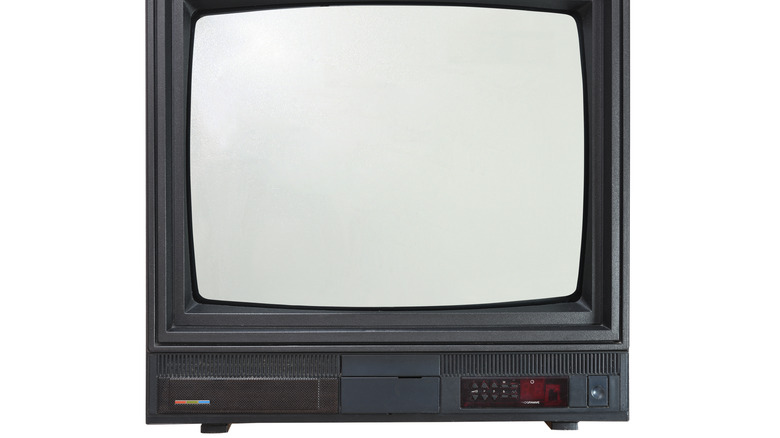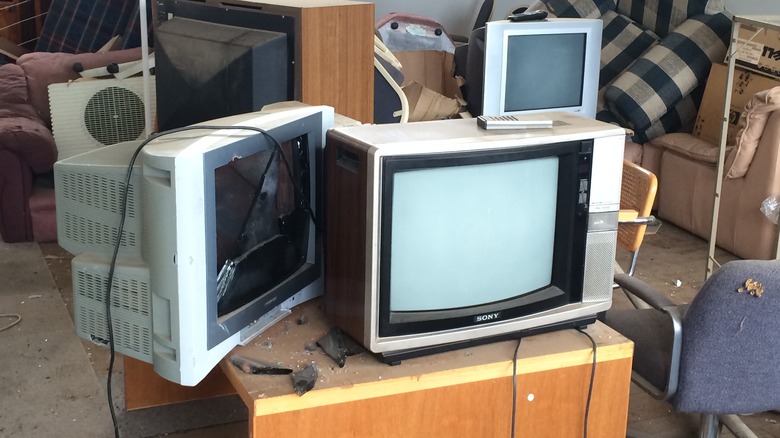The Reason Old CRT TVs Are Making A Big Comeback
Generally speaking, the models of any given device are quickly superseded. Many of us, naturally, do our very best to keep up with the latest additions, as we just can't resist the latest tech. As far as media is concerned, in particular, we want to watch shows and movies and play the video games we love in the greatest quality possible. As an inevitable consequence of the constant improvement of technology, however, we lose access to some previous content along the way, just as surely as our old flatscreen TVs become obsolete.
Some of us have stacks of VHS tapes squirreled away, but no real way to watch them anymore. They may still have value, though, among connoisseurs of the format. By the same token, video game consoles that were designed in the 1990s were created for TVs of the era, so the experience may not be quite as optimal on a modern TV. Indeed, certain games may not be compatible with them at all.
The retro gaming boom, then, comes hand in hand with the retro TV boom.
The sweet nostalgia of a CRT TV
The most famous example of a CRT TV-only title, perhaps, is NES classic Duck Hunt. It worked by means of the NES Zapper, a neat yet simple peripheral that Today I Found Out on YouTube explains "primarily just consists of a button, the trigger, and a photodiode." What this means is that shooting blacked out the screen for the briefest moment, and the photodiode could then determine whether the player scored a hit by determining whether the light changed in that area of the frame after the shooting.
Today's HD TVs, lacking IR, can't function in this way, so Duck Hunt isn't playable without potential hacks or modifications being made. In addition to such issues, CRT TVs were designed to make rather pixelated titles a little easier on the eye through scanlines and the shape of the display itself. The need to bring adaptors and such into the equation can make it rather more difficult to set them up, but for that authentic retro feeling, there's nothing quite like using the original technology. There's a reason why many of today's retro-inspired titles provide options like filters to simulate the CRT experience.
Collectors and hobbyist players alike, then, have been keen to rekindle their passion for CRT TVs.
Acquiring CRT TVs
Such TVs are not, of course, as easily available at retailers today. It wouldn't be nearly as easy to arrange an event similar to the UK's Record Store Day, which vinyl enthusiasts have enjoyed every April 22 since 2008. Ahead of that event in 2023, the Entertainment Retailers Association's Megan Page told Music Week, "In 2007 there were less than 200,000 vinyl units sold in the UK and now we're over 5.5 million."
By 2009, in contrast, CRT TVs were holding their own against the rise of newer TV tech, as a more affordable alternative, but were not being widely manufactured around the world.
CRT TVs may be niche for gaming, but they offer certain advantages over even the latest TV tech. As Linus Tech Tips on YouTube notes, "They have next to no input lag. Their pixel response times are ... instantaneous, and they have high contrast ratio." It's vital to note, though, that such high-end CRT devices absolutely don't come cheap. In 2022, Linus Tech Tips purchased the Sony GDM FW900, "the greatest monitor that money can buy." The model, resplendent with the virtues of top-quality CRTs, can cost more than $3000. The market for CRTs on websites like eBay can be difficult to navigate, with factors like the condition of the TV of vital importance. Nonetheless, there is still a market for them today and they certainly still have their uses.


